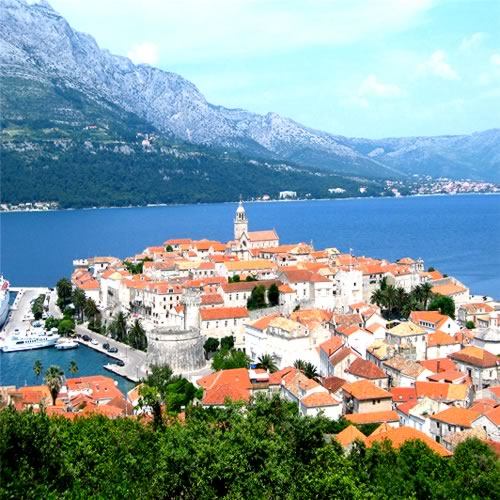Day 1 on Korcula Island
Welcome to Croatia! Upon arrival, you will go through customs and immigration. Should you opt to purchase a transfer to your hotel, a representative will be waiting for you as you exit immigration. Otherwise, make your way to Korcula Island and arrive at your hotel. Check in and do not give in to jet lag! There is so much for you to see and do!
On the first day, you should get yourself acquainted with the largest town on the island, also named Korcula. The Old Town is built on a small fortified peninsula, just 700 feet wide by 700 feet long, and many large portions of the fortifications still exist today. You will enter through the town gates, which are located between the Square of Reconciliation (Trg Pomirenja) which sits on the southwestern outside edge of the peninsula, and King Tomislav Square on the southeastern outside edge.
The streets fan out from the central avenue in a herringbone pattern. On the highest point in the middle of the peninsula, you will find Korcula Cathedral, also called the Cathedral of St. Mark, built in the sixteenth century. You`ll find a number of other sights on St. Mark`s Square, such as the Korcula Town Museum, the Bishop`s Treasury, and the Church of Our Lady. Northeast of St. Mark`s Square, you`ll find the oldest church in the Old Town, dating from the 14th century, the Gothic Church of St. Peter. Nearby you will see the Marco Polo House, the ruins of a 17th-century house which offers great views of the town. The house of course isn`t from Marco Polo`s time, but it is believed to have been where his house once stood when he lived there in the 1290s. (Some even claim the house is his birthplace; he was more likely to have been born in Venice.)
If you want to know more about the life`s work of the famed explorer, who is irrevocably tied to Korcula whether he was born here or not, you can visit the Marco Polo Museum that sits off St. Justine Square, which is north of the waterfront and south of King Tomislav Square. Explore the waterfront as the sun sets by walking along the Obala korculanskih brodograditelj (Korcula Shipbuilders Shore Road). You can eat dinner at one of the restaurants and cafés along the way. Head back to your accommodations at the end of the day.



Day 2 on Korcula Island
Enjoy a leisurely breakfast in Korcula before heading west on the main road to the other side of the island. Taxis will gladly take you on the journey, provided you pay extra for waiting time. In the middle of the island, there are two towns, Cara and Smokvica, that are well-known for their wineries. Consider touring a winery, taste-testing Korcula`s vintage, and finding a great souvenir bottle of wine to take home with you. Then head west to Vela Luka, the main settlement on the western side of Korcula Island.
Vela Luka means `large bay` in Croatian, and that makes sense, as one arm of the bay stretches nearly a half-mile into the island just northeast of the center of town. Head to Vela Spila, located on a hillside just above the bay. It is a cavern which was formed beginning in the Mesolithic period (around 20,000 BCE), which was also when the first humans found the area. You can find prehistoric artifacts from the caves at the Museum Collections of the Vela Luka Cultural Centre, located in the center of town just one street away from the marina. Also at the museum, you`ll find a local ethnographic collection and an assortment of folk costumes from Korcula Island.
If you are still in the area by sunset, head southwest of town to Hum Fortress, an abandoned fortress built during the early Habsburg Empire. The fortress`s position affords unrivaled views of much of Korcula Island. Return to your accommodations at the end of the day.


Additional Days on Korcula Island
If you want to have a beach day and you have extra time on Korcula Island, head southeast of Korcula Town to Lumbarda, widely considered the top beach destination on the island. The favored beaches in the area are located to the east of town, on opposite sides of a narrow isthmus. On the north side, there is Lumbarda Beach, and on the south side, you will find Vela Przina Beach.
If you are looking for a traditional Korcula town to explore, consider making time for Blato on your way to Vela Luka from Korcula Town. Blato is one of the oldest settlements on the island and there are a number of Roman and Illyrian ruins in the area. Blato is well-known for its folk festivals, its lime trees, and cork oak trees. You can find both along the main street, Zlinje, and in the town park.

Your Last Day on Korcula Island
Depart your hotel and head to your next destination, whether it is another island in the Adriatic or a town on the Dalmatian mainland. If this is the final stop on your trip, head to the airport and return home. We hope you enjoyed the sights of Korcula Island!
